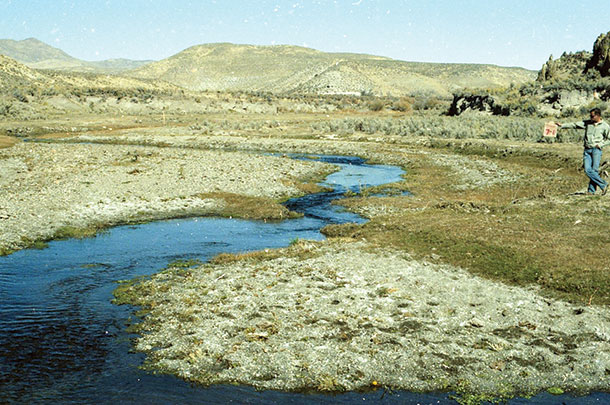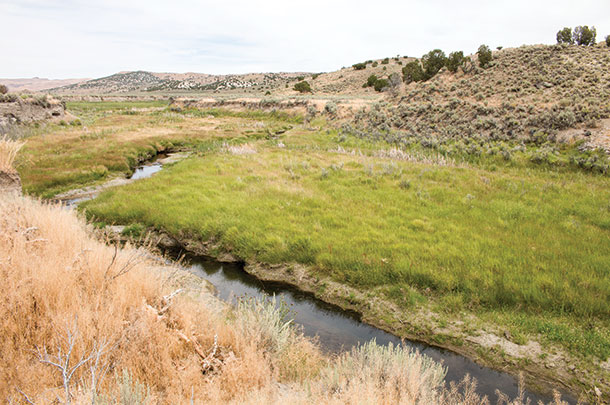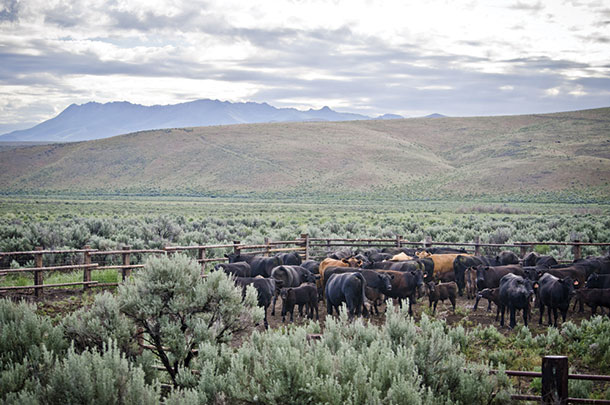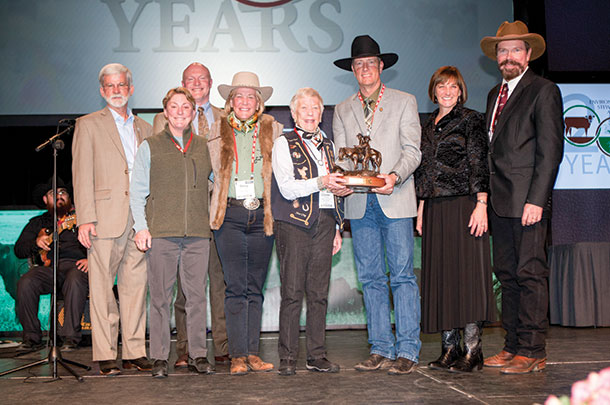Sure, one sports a vaquero hat and a pair of high-top boots while the other laces up some hiking shoes, but that’s not what we’re talking about. We’re talking about men and women that have a common vision – and that’s caring for the land.
In the sagebrush country of northeast Nevada, just 10 miles west of Elko, is the home of Maggie Creek Ranch. Owned by the Bill and Sally Searle family, the 200,000-plus-acre ranch stretches across some of the roughest country in the U.S.
With an average of 8 to 10 inches of precipitation and a district average of about 150 fires for approximately 100,000 acres, it makes running a cow-calf and stocker enterprise challenging. But it doesn’t end there; about two-thirds of Maggie Creek Ranch is owned and one-third is permitted on public grazing lands – creating a whole other set of challenges.
Despite the ongoing battles between ranchers and federal agencies, Jon Griggs (the ranch manager) and the rest of the Maggie Creek crew have gone above and beyond, not only in caring for their land and cattle but also in fostering relationships.
A common vision
For 18 years, Griggs has worked with groups such as the Bureau of Land Management (BLM), U.S. Fish and Wildlife Service and Trout Unlimited on a number of conservation projects for ranch enhancement.
Griggs says, “I think BLM as an agency and we as ranchers pretty much have the same goals. For the most part, we are on the same page on how we want things to be. So when you start there and recognize that and try to build upon that, as opposed to going against each other, you can do some pretty neat things together.”
One of the biggest accomplishments on Maggie Creek Ranch is their collaborative effort in improving rangeland and riparian conditions within the Susie and Maggie Creek watersheds on both public and private ground.
By constructing riparian pastures at various locations and changing their grazing, cattle no longer roam freely along the watersheds. This has allowed these areas to recover from what was once a point of concern to what now could be referred to as a “desert oasis.”
“When I came in the early ’90s, before the project really started, Susie Creek would have been solid gravel with some sagebrush not far off the creek and pretty much no green vegetation,” Griggs explains. “And at that time, it would dry up every year. It wasn’t a matter of reducing our grazing so much as it was changing when and where we grazed.”

Instead of hot-season or year-long grazing, like the ranch once allowed, Griggs says they started rotating their cattle through pastures. It wasn’t long before they noticed some pretty dramatic changes: The stream became narrower and deeper, and the vegetation around the stream began to grow.

Pretty soon, the watershed was engulfed in willow trees and, as any rancher would, Griggs says he began having second thoughts. But with the willows came beavers, and it wasn’t long before the beavers ate themselves out of house and home.
“What the beavers did is: They really slowed the water down and raised the flood plane up a little bit,” Griggs says. “Now, we have this big green meadow that we can gather the cows into, and we can wean the calves here and adjust the rumens to some green forage and get some decent feed in before they go through the stress of weaning. It made pretty dramatic changes in 10 years, but it’s evolving all the time.”
Griggs says last year was the real test to see how well the watersheds were performing. With four consecutive years of drought, and only a few timely spring rains, there was never enough water. Fortunately for them, the Susie Creek and Maggie Creek watersheds carried enough water and were essentially their “saving grace” that year.
“On a ranch like this one, water is so important, and if you don’t protect it, you don’t have it,” he says. “From year to year, your forage will vary, but if you don’t have water, then it doesn’t do any good. I think that’s something about the BLM grazing permits; we’ve had to take credit for it, and they’ll help you with it, even if it’s just knowledge.”
Range management
To combat fires and invasive species, both private and public ground on Maggie Creek Ranch is often reseeded post-fire. Griggs says reseeding with species such as forage kochia, crested wheatgrass, basin wildrye, Junegrass and needle-and-thread grass helps them get a jump on cheatgrass from coming back and dominating the area.
While some ranchers don’t hate cheatgrass as much as they should, Griggs says they work hard to reduce the density of this invasive species on their ranch. It may be one of the first species to green up in the spring, but it is also one of the quickest species to burn, he says.

When it comes to grazing management, Griggs explains that one of their goals on the ranch is to allow every plant the opportunity to reach seedhead maturity each year. Although they don’t always reach that, it’s a goal they strive for. To do so, they focus on moving cattle early and often in the spring.
Griggs explains that cattle start out in the ranch’s low country to calve and then, as calves are able to travel toward higher country, the crew begins moving the herd to summer pastures, branding calves at a few different locations along the trail.
Come summertime, the herd is shuffled around the mountain and then gathered and moved back toward the riparian pastures in the fall to wean calves. The calves are trucked home and the cycle repeats, he says.
The challenges
Although Griggs may sound like his experience with federal agencies has been “a bed of roses,” he’ll be the first to admit that these relationships haven’t came without their own set of challenges.
“It can be hard to get things like this done,” Griggs says, explaining how hard it was to get a cattle guard installed on one of his allotments. “If you think of it from a BLM person standpoint, if one cattle guard takes you 15 months to get done, think about 5 or 6 miles of fence. So if I come to you asking for a new fence, what are you motivated to do? You’re motivated to tell me no because that’s the easiest route, right?”

Griggs says people recognize the way federal lands are managed is broken to some extent. Incidences such as the Cliven Bundy fiasco and other disagreements are becoming increasingly frequent as people start looking for solutions.
“Fortunately for us, we have good people to work with. Not everyone has that, and not every BLM person has good ranchers to work with either – it really goes both ways. But for the most part, I think most ranchers are like me, and most BLM people are like the people I deal with. We want to do the right thing on the ground and have good relationships,” he says.
Like many ranchers, Griggs says the improvements made on Maggie Creek Ranch were something he dreamed of but never thought possible. Thanks to some cooperative federal employees and a willing permittee, Maggie Creek Ranch is well on its way to preserving the land for future generations. ![]()
PHOTO 1: Jon Griggs looks over one of his allotments drill-seeded with crested wheatgrass, forage kochia and fourwing saltbrush in 2008. Photo by Cassidy Woolsey.
PHOTO 2: Susie Creek before the project. Photo provided by Jon Griggs.
PHOTO 3: Susie Creek after the project. The photo was taken in July 2016. Photo by Cassidy Woolsey.
PHOTO 4: Griggs maintains an Angus-based cowherd, breeding to Angus, Sim-Angus and Balancer bulls. The heifers begin calving around the first of March and the cows start in mid-March, finishing up about the end of May. Photo provided by Jon Griggs.
PHOTO 5: Sally Searle and Jon Griggs (middle) receiving the 2015 Environmental Stewardship Award along with members of the Searle family at the NCBA Cattle Industry Convention. Photo by NCBA.

-
Cassidy Woolsey
- Editor
- Progressive Cattleman
- Email Cassidy Woolsey








